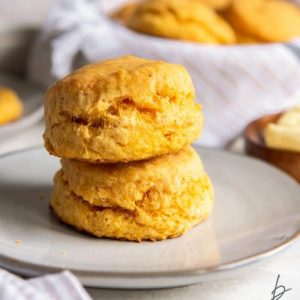
Fluffy Sweet Potato Biscuits
Soft, buttery, and subtly sweet, these Sweet Potato Biscuits are a quick, fiber-rich comfort food perfect for breakfast, brunch, or as a side. Made from scratch with wholesome ingredients, they offer good fats, plant-based nutrients, and a satisfying texture that’s easy to prepare in under 30 minutes.
Equipment
- 1 kitchen scale
- 1 Pastry cutter
- 1 3-inch biscuit cutter
- 1 Baking sheet
- Parchment Paper
Ingredients
- 1 ⅔ cups 208 g all-purpose flour
- 3 tablespoons 38 g light brown sugar
- 1 tablespoon baking powder
- ½ teaspoon salt
- ½ cup 113 g cold unsalted butter, cut into ½-inch pieces
- 1 cup 220 g sweet potato purée (see notes)
- ½ cup 120 ml cold buttermilk
- 1 tablespoon melted butter for brushing
Instructions
- Preheat and prepare baking surface: Begin by preheating your oven to 425°F (220°C) to ensure a hot baking environment, which is essential for producing biscuits with a tender interior and a golden crust. Line a baking sheet with parchment paper to prevent sticking and make cleanup easier. Place the prepared baking sheet nearby for convenience.
- Combine dry ingredients: In a large mixing bowl, measure and add all-purpose flour, light brown sugar, baking powder, and salt. Stir gently with a whisk or spoon until the ingredients are evenly combined. This step ensures the sweetness, leavening, and seasoning are well distributed throughout the biscuit dough.
- Cut in cold butter: Add the cold, unsalted butter (cut into ½-inch cubes) to the dry mixture. Use a pastry cutter, two forks, or your fingertips to cut the butter into the flour until the mixture resembles coarse crumbs, similar to fine cornmeal. The small butter pieces are essential for creating flaky biscuit layers, so avoid overmixing.
- Mix sweet potato and buttermilk: In a separate bowl, combine sweet potato purée and cold buttermilk. Whisk together until smooth. This mixture provides moisture, flavor, and tenderness to the biscuits. Ensure the purée is fully blended to avoid lumps and to evenly distribute sweetness.
- Incorporate wet mixture into dry ingredients: Pour the sweet potato-buttermilk blend into the bowl with the flour and butter mixture. Stir gently with a wooden spoon or spatula just until the dough comes together. Avoid overmixing to prevent tough biscuits. If the dough appears dry with flour pockets, add buttermilk one tablespoon at a time until evenly moistened. If too wet, incorporate flour gradually until workable.
- Knead lightly for structure: Transfer the dough onto a lightly floured surface. Knead gently three to four times by folding and pressing. This step develops structure without compromising tenderness. Over-kneading can lead to dense biscuits, so keep kneading minimal and intentional.
- Shape the dough: Pat or roll the dough out to approximately 1-inch thickness using your hands or a rolling pin. Ensure an even thickness for consistent baking. Lightly dust your biscuit cutter with flour to prevent sticking. Press straight down without twisting to create clean biscuit edges and maintain proper rise.
- Arrange biscuits on sheet: Place each biscuit on the prepared baking sheet, spacing them about 1 inch apart. This spacing allows heat to circulate and encourages biscuits to rise upward rather than outward, resulting in a soft and tender interior.
- Bake to golden perfection: Transfer the baking sheet to the preheated oven and bake at 425°F (220°C) for 18 to 22 minutes, or until the biscuits are golden brown and sound hollow when tapped lightly. Baking time may vary slightly depending on your oven, so check biscuits toward the end.
- Brush with butter and serve warm: While the biscuits bake, melt a tablespoon of unsalted butter. As soon as the biscuits come out of the oven, brush them generously with melted butter to enhance flavor and give a glossy finish. Serve immediately for best texture and warmth.
Notes
- Sweet Potato Purée: For best results, prepare homemade purée by peeling and chopping a medium sweet potato into chunks. Boil until tender (about 12–15 minutes), drain well, mash thoroughly, and allow to cool completely before use. If using canned purée, ensure it’s patted dry with a towel to remove excess moisture, which could otherwise require more flour to maintain dough consistency.
- Butter Temperature: Keep butter cold until the moment it’s cut into the flour mixture. This is essential for creating flaky layers in the biscuits.
- Biscuit Cutter: Dust the biscuit cutter with flour before each use to ensure clean cuts and avoid sticking. Twist the cutter straight down without rotating to preserve biscuit rise.
- Spacing on Baking Sheet: Position biscuits relatively close together (about 1 inch apart) to encourage upward rising and achieve soft sides rather than crispy edges.